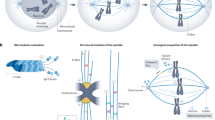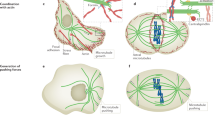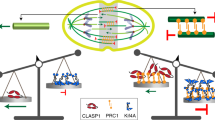Abstract
Metaphase spindles are microtubule-based structures that use a multitude of proteins to modulate their morphology and function. Today, we understand many details of microtubule assembly, the role of microtubule-associated proteins, and the action of molecular motors1,2. Ultimately, the challenge remains to understand how the collective behaviour of these nanometre-scale processes gives rise to a properly sized spindle on the micrometre scale. By systematically engineering the enzymatic activity of XMAP215, a processive microtubule polymerase3,4, we show that Xenopus laevis spindle length increases linearly with microtubule growth velocity, whereas other parameters of spindle organization, such as microtubule density, lifetime and spindle shape, remain constant. We further show that mass balance can be used to link the global property of spindle size to individual microtubule dynamic parameters. We propose that spindle length is set by a balance of non-uniform nucleation and global microtubule disassembly in a liquid-crystal-like arrangement of microtubules.
This is a preview of subscription content, access via your institution
Access options
Subscribe to this journal
Receive 12 print issues and online access
$209.00 per year
only $17.42 per issue
Buy this article
- Purchase on Springer Link
- Instant access to full article PDF
Prices may be subject to local taxes which are calculated during checkout




Similar content being viewed by others
References
Walczak, C. E. & Heald, R. Mechanisms of mitotic spindle assembly and function. Int. Rev. Cytol. 265, 111–158 (2008).
Gatlin, J. C. & Bloom, K. Microtubule motors in eukaryotic spindle assembly and maintenance. Semin. Cell Dev. Biol. 21, 248–254 (2010).
Kinoshita, K., Arnal, I., Desai, A., Drechsel, D. N. & Hyman, A. A. Reconstitution of physiological microtubule dynamics using purified components. Science 294, 1340–1343 (2001).
Brouhard, G. J. et al. XMAP215 is a processive microtubule polymerase. Cell 132, 79–88 (2008).
Levy, D. L. & Heald, R. Mechanisms of intracellular scaling. Annu. Rev. Cell Dev. Biol. 28, 113–135 (2012).
Chan, Y-H. M. & Marshall, W. F. How cells know the size of their organelles. Science 337, 1186–1189 (2012).
Goehring, N. W. & Hyman, A. A. Organelle growth control through limiting pools of cytoplasmic components. Curr. Biol. 22, R330–R9 (2012).
Goshima, G., Wollman, R., Stuurman, N., Scholey, J. M. & Vale, R. D. Length control of the metaphase spindle. Curr. Biol. 15, 1979–1988 (2005).
Burbank, K. S., Mitchison, T. J. & Fisher, D. S. Slide-and-cluster models for spindle assembly. Curr. Biol. 17, 1373–1383 (2007).
Loughlin, R., Wilbur, J. D., McNally, F. J., Nédélec, F. J. & Heald, R. Katanin contributes to interspecies spindle length scaling in Xenopus. Cell 147, 1397–1407 (2011).
Brugués, J., Nuzzo, V., Mazur, E. & Needleman, D. J. Nucleation and transport organize microtubules in metaphase spindles. Cell 149, 554–564 (2012).
Shimamoto, Y., Maeda, Y. T., Ishiwata, S., Libchaber, A. J. & Kapoor, T. M. Insights into the micromechanical properties of the metaphase spindle. Cell 145, 1062–1074 (2011).
Mitchison, T. J. T. et al. Roles of polymerization dynamics, opposed motors, and a tensile element in governing the length of Xenopus extract meiotic spindles. Mol. Biol. Cell 16, 3064–3076 (2005).
Needleman, D. J. et al. Fast microtubule dynamics in meiotic spindles measured by single molecule imaging: evidence that the spindle environment does not stabilize microtubules. Mol. Biol. Cell 21, 323–333 (2010).
Yang, G. G. et al. Architectural dynamics of the meiotic spindle revealed by single-fluorophore imaging. Nat. Cell Biol. 9, 1233–1242 (2007).
Howard, J. & Hyman, A. A. Microtubule polymerases and depolymerases. Curr. Opin. Cell Biol. 19, 31–35 (2007).
Al-Bassam, J. & Chang, F. Regulation of microtubule dynamics by TOG-domain proteins XMAP215/Dis1 and CLASP. Trends Cell Biol. 21, 604–614 (2011).
Widlund, P. O. et al. XMAP215 polymerase activity is built by combining multiple tubulin-binding TOG domains and a basic lattice-binding region. Proc. Natl Acad. Sci. 108, 2741–2746 (2011).
Kinoshita, K. Aurora A phosphorylation of TACC3/maskin is required forcentrosome-dependent microtubule assembly in mitosis. J. Cell Biol. 170, 1047–1055 (2005).
Zanic, M., Stear, J. H., Hyman, A. A. & Howard, J. EB1 recognizes the nucleotide state of tubulin in the microtubule lattice. PLoS ONE 4, e7585 (2009).
Maurer, S. P., Fourniol, F. J., Bohner, G., Moores, C. A. & Surrey, T. EBs recognize a nucleotide-dependent structural cap at growing microtubule ends. Cell 149, 371–382 (2012).
Wuehr, M. et al. Evidence for an upper limit to mitotic spindle length. Curr. Biol. 18, 1256–1261 (2008).
Hamada, T., Itoh, T. J., Hashimoto, T., Shimmen, T. & Sonobe, S. GTP is required for the microtubule catastrophe-inducing activity of MAP200, a tobacco homolog of XMAP215. Plant Physiol. 151, 1823–1830 (2009).
Popov, A. V., Severin, F. & Karsenti, E. XMAP215 is required for the microtubule-nucleating activity of centrosomes. Curr. Biol. 12, 1326–1330 (2002).
Groen, A. C., Maresca, T. J., Gatlin, J. C., Salmon, E. D. & Mitchison, T. J. Functional overlap of microtubule assembly factors in chromatin-promoted spindle assembly. Mol. Biol. Cell 20, 2766–2773 (2009).
Slep, K. C. & Vale, R. D. Structural basis of microtubule plus end tracking by XMAP215, CLIP-170, and EB1. Mol. Cell 27, 976–991 (2007).
Vasquez, R. J., Gard, D. L. & Cassimeris, L. XMAP from Xenopus eggs promotes rapid plus end assembly of microtubules and rapid microtubule polymer turnover. J. Cell Biol. 127, 985–993 (1994).
Walker, R. A. et al. Dynamic instability of individual microtubules analyzed by video light microscopy: rate constants and transition frequencies. J. Cell Biol. 107, 1437–1448 (1988).
Verde, F., Dogterom, M., Stelzer, E., Karsenti, E. & Leibler, S. Control of microtubule dynamics and length by cyclin A- and cyclin B-dependent kinases in Xenopus egg extracts. J. Cell Biol. 118, 1097–1108 (1992).
Dogterom, M. & Leibler, S. Physical aspects of the growth and regulation of microtubule structures. Phys. Rev. Lett. 70, 1347–1350 (1993).
Loughlin, R., Heald, R. & Nedelec, F. A computational model predicts Xenopus meiotic spindle organization. J. Cell Biol. 191, 1239–1249 (2010).
Hyman, A. & Karsenti, E. The role of nucleation in patterning microtubule networks. J. Cell Sci. 111, 2077–2083 (1998) Pt 15.
Gruss, O. J. The mechanism of spindle assembly: functions of Ran and its target TPX2. J. Cell Biol. 166, 949–955 (2004).
Petry, S., Pugieux, C., Nédélec, F. J. & Vale, R. D. Augmin promotes meiotic spindle formation and bipolarity in Xenopus egg extracts. Proc. Natl Acad. Sci. USA 108, 14473–14478 (2011).
Gatlin, J. C., Matov, A., Danuser, G., Mitchison, T. J. & Salmon, E. D. Directly probing the mechanical properties of the spindle and its matrix. J. Cell Biol. 188, 481–489 (2010).
Itabashi, T. et al. Probing the mechanical architecture of the vertebrate meiotic spindle. Nat. Methods 6, 167–172 (2009).
Inoué, S. Microtubule dynamics in cell division: exploring living cells with polarized light microscopy. Annu. Rev. Cell Dev. Biol. 24, 1–28 (2008).
Mitchison, T. J. et al. Bipolarization and poleward flux correlate during Xenopus extract spindle assembly. Mol. Biol. Cell 15, 5603–5615 (2004).
Isenberg, I. On the theory of the nematic phase and its possible relation to the mitotic spindle structure. Bull. Math. Biophys. 16, 83–96 (1954).
Hannak, E. & Heald, R. Investigating mitotic spindle assembly and function in vitro using Xenopus laevis egg extracts. Nat. Protoc. 1, 2305–2314 (2006).
Hyman, A. et al. Preparation of modified tubulins. Methods Enzymol. 196, 478–485 (1991).
Gell, C. et al. Purification of tubulin from porcine brain. Methods Mol. Biol. 777, 15–28 (2011).
Reber, S., Over, S., Kronja, I. & Gruss, O. J. CaM kinase II initiates meiotic spindle depolymerization independently of APC/C activation. J. Cell Biol. 183, 1007–1017 (2008).
Rink, J., Ghigo, E., Kalaidzidis, Y. & Zerial, M. Rab conversion as a mechanism of progression from early to late endosomes. Cell 122, 735–749 (2005).
Kalaidzidis, L. Y., Gavrilov, A. V., Zaitsev, P. V., Kalaidzidis, A. L. & Korolev, E. V. PLUK—an environment for software development. Prog. Comput. Softw. 23, 206–211 (1997).
Mirny, L. A. & Needleman, D. J. Quantitative characterization of filament dynamics by single-molecule lifetime measurements. Methods Cell Biol. 95, 583–600 (2010).
Wilde, A. et al. Ran stimulates spindle assembly by altering microtubule dynamics and the balance of motor activities. Nat. Cell Biol. 3, 221–227 (2001).
Brown, K. S. et al. Xenopus tropicalis egg extracts provide insight into scaling of the mitotic spindle. J. Cell Biol. 176, 765–770 (2007).
Acknowledgements
We are grateful to A. Bird, C. Brangwynne, M. Braun, N. Goehring, J. Gopalakrishnan, O. Gruss, G. Salbreux, M. Zanic and D. Zwicker for critical evaluation of the manuscript. We thank all members of the Howard, Hyman and Jülicher laboratories for continuous discussions, H. Andreas for frog care, O. Gruss for the XKCM1 antibody, and Y. Kalaidzidis and M. Chernykh for help with the tracking software. P.O.W. was supported by an EMBO long-term fellowship. J.B. is supported by the European Commission’s 7th Framework Programme grant Systems Biology of Mitosis (FP7-HEALTH-2009-241548/MitoSys). S.R. is supported by the European Commission’s 7th Framework Programme grant Systems Biology of Stem Cells and Reprogramming (HEALTH-F7-2010-242129/SyBoSS).
Author information
Authors and Affiliations
Contributions
This work represents a truly collaborative effort. Each author has contributed significantly to the findings and regular group discussions guided the development of the ideas presented here.
Corresponding authors
Ethics declarations
Competing interests
The authors declare no competing financial interests.
Integrated supplementary information
Supplementary Figure 1 XMAP215 TOG1-5AA binds to spindle microtubules and XTACC3.
(a) Xenopus egg extract was MOCK or XMAP215 depleted, recombinant GFP-tagged XMAP215 wildtype (WT) or TOG1-5AA protein was added back to 120 nM, which is the endogenous concentration. Tubulin was used as a loading control. (b) A spindle assembled in XMAP215-depleted Xenopus egg extract in the presence of recombinant XMAP215-GFP (WT) or TOG1-5AA-GFP to 120 nM. Although the full mutant XMAP215 TOG1-5AA no longer binds tubulin, it still localizes to spindle microtubules. Note that spindles assembled in the presence of TOG1-5AA are much smaller than wildtype spindles, also at high concentrations. Scale bar: 10 μm (c) Pulldown of recombinant proteins from Xenopus egg extract on anti GFP-beads, beads eluate was analyzed by Western Blot for the presence of XTACC3. (d) Spindles were assembled in the presence of XMAP215 or the full mutant XMAP215 TOG1-5AA at the indicated concentrations. The upper row shows representative spindles (red: microtubules, blue: DNA), the lower row shows an average image of all spindles (n = 40, assessed over three independent experiments). Scale bar: 10 μm (e) Spindle length (Fig. 1c) plotted versus the in vitro microtubule growth velocities promoted by different XMAP215 mutants at 100 nM (as compared to the maximum growth promotion at 400 nM, shown in Fig. 1h). Error bars indicate SE (ny = 40 spindles assessed over 3 independent experiments; nx = WT 11(2), 5AA 15(2), 3&4AA 11(2), 1AA 11 (2), 1&2AA 15 (2), 1-5 AA no growth. Nx = independent measurements of individual growth events. Number of independent experiments for each condition is given in parentheses.). Grey area indicates the 95% confidence interval of the fitted linear function. (f) Microtubule growth velocities measured at different XMAP215 concentrations in a TIRF assay. The mean growth velocity is indicated by open circles, individual data points by dots (n = 10 independent measurements of individual growth events), which were fitted with Michaelis–Menten kinetics. Grey area indicates the 95% confidence interval of the fitted function.
Supplementary Figure 2 Depleting XKCM1 from Xenopus egg extracts increases microtubule lifetime.
(a) CSF-extract was immuno-depleted of XKCM1 (2ndΔ), one volume of fresh CSF-extract was added back to obtain 50% of endogenous XKCM1 concentration. (b) Spindles were assembled in the presence of Fluor647-tubulin and imaged with an Olympus IX81 spinning disc confocal microscope. Distribution of tubulin lifetimes in spindles assembled in control extracts (blue) with τ = 5.1±0.3 s (SE, n = 60 bins, 13 745 tracks from 12 spindles assessed from 3 independent experiments) and XKCM1-depleted extracts (orange) with τ = 7.8±0.4 s (SE, n = 60 bins, 63 583 tracks from 13 spindles assessed from 3 independent experiments). All data were fitted with a sum of two exponentials, the grey areas indicate the 95% confidence intervals. Note that the setup of the microscope used to determine the lifetimes in Fig. 4b was different (see Methods).
Supplementary Figure 3 Reduction in microtubule density at the spindle centre is due to volume exclusion by DNA.
Microtubule density (bold line) along the longitudinal spindle axis was quantified by the incorporated Cy3-tubulin fluorescence. The variation in intensity along the axis is due to volume exclusion by the DNA, as quantified by the DAPI signal (thin line). The graphs show an average fluorescence intensity of 15 spindles per XMAP215 concentration. The chromatin width was estimated by fitting a Gaussian to the DAPI intensity profiles (SE, n = 15 spindles per concentration).
Supplementary Figure 4 Spindle volume.
(a) Individual data points of spindle volume versus spindle length at different XMAP215 concentrations fitted by a power law (exponent: 1.96±0.18 (SE, n = 60 spindles assessed over 3 different experiments). (b) Individual data points of spindle height versus spindle length at different XMAP215 concentrations fitted by a linear function. (c) Spindle volume versus microtubule growth velocity by combing fits from Supplementary Fig. S4a and Fig. 2f. Grey areas indicate the 95% confidence interval of the fitted functions.
Supplementary information
Supplementary Information
Supplementary Information (PDF 3529 kb)
Rights and permissions
About this article
Cite this article
Reber, S., Baumgart, J., Widlund, P. et al. XMAP215 activity sets spindle length by controlling the total mass of spindle microtubules. Nat Cell Biol 15, 1116–1122 (2013). https://doi.org/10.1038/ncb2834
Received:
Accepted:
Published:
Issue Date:
DOI: https://doi.org/10.1038/ncb2834
This article is cited by
-
Acentrosomal spindles assemble from branching microtubule nucleation near chromosomes in Xenopus laevis egg extract
Nature Communications (2023)
-
Mechanisms underlying spindle assembly and robustness
Nature Reviews Molecular Cell Biology (2023)
-
Phase separation of TPX2 enhances and spatially coordinates microtubule nucleation
Nature Communications (2020)
-
XMAP215 is a microtubule nucleation factor that functions synergistically with the γ-tubulin ring complex
Nature Cell Biology (2018)
-
Mitotic spindle assembly in animal cells: a fine balancing act
Nature Reviews Molecular Cell Biology (2017)



